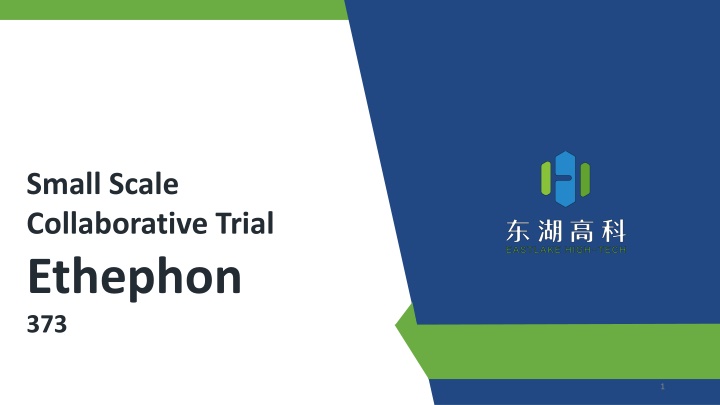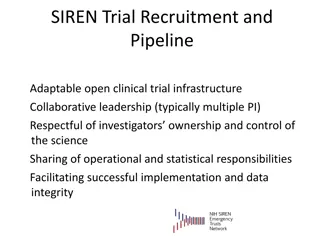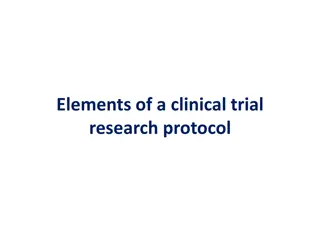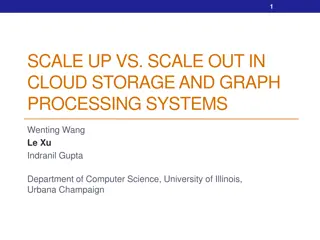Small Scale Collaborative Trial: Ethephon 373 Overview
In-depth analysis of Ethephon 373 including general information, existing CIPAC method (Titration), introduction to new method (Ion Chromatography), calibration sample preparation, and determination process. Explore the methodology, advantages, challenges, and key findings of small-scale trials. View images for visual insights.
Uploaded on Mar 19, 2025 | 1 Views
Download Presentation

Please find below an Image/Link to download the presentation.
The content on the website is provided AS IS for your information and personal use only. It may not be sold, licensed, or shared on other websites without obtaining consent from the author.If you encounter any issues during the download, it is possible that the publisher has removed the file from their server.
You are allowed to download the files provided on this website for personal or commercial use, subject to the condition that they are used lawfully. All files are the property of their respective owners.
The content on the website is provided AS IS for your information and personal use only. It may not be sold, licensed, or shared on other websites without obtaining consent from the author.
E N D
Presentation Transcript
Small Scale Collaborative Trial Ethephon 373 1
Catalog 01 Background 02 New method introduction Single laboratory validation 03 04 Small scale trial results Conclusion and recommendation 05 2
1. 1 General Information of Ethephon ISO common name Ethephon 2-Chloroethyl phosphonic acid (IUPAC); (2- Chloroethyl) phosphonic acid 16672-87-0 C2H6ClO3P 144.5 74 - 75 2.5, 7.2 Chemical name CAS No. Empirical formula RMM Melting point pKa Water: > more than 1000 g/l; soluble in ethanol and propane-1,2-diol; sparingly soluble in aromatic solvents Solubility Description White to slightly colored crystals Stability Stable at pH less than 3.5; decomposes at higher pH values 3
1.2 Existing CIPAC Method-Titration(373/TK/M/- and 373/SL/M-) The sample is neutralized to pH 9.3 to form the ethephon disodium salt, which is decomposed to ethene and sodium dihydrogen phosphate on heating. Sodium dihydrogen phosphate is determined by acidimetry. (i) Formation of ethephon disodium salt Cl-CH2-CH2-P(O)(OH)2+ 2NaOH Cl-CH2-CH2-P(O)(ONa)2+ 2H2O Advantages: easy handling cost effectiveness Challenges: Rely on person, less objective and stable Non-specific (ii) Thermal decomposition of ethephon disodium salt Cl-CH2-CH2-P(O)(ONa)2+ H2O CH2=CH2+ NaCl + (HO)2P(O)(ONa) (iii) Neutralisation of sodium dihydrogen phosphate (HO)2P(O)(ONa) + NaOH (HO)-P(O)(ONa)2+ H2O 4
2.1 New method introduction-Ion Chromatography Apparatus Ethephon is determined by ion chromatography using electrolytic conductivity detector and external standardization. The analytical column used is based on alkanol quaternary ammonium. Chromatographic conditions (typical) Eluent: NaHCO3 Flow rate: Current of inhibitor: Temperature of detector cell: Temperature of column: Mode of injection: Volume of Injection: Frequency of data sampling: Run time: Retention time: 7.2 mM Na2CO3+ 9.0 mM 1.0 mL/min 70 mA 35 30 PushFull 25 L 5.0 Hz 13 min 9.5 min 5
2.2 Procedure Preparation of Calibration sample. Prepare sample solutions in duplicate. Weigh (to the nearest 0.1 mg) sufficient sample (w mg) to contain about 120 mg of Ethephon into a brown volumetric flask (100 ml). Add ultrapure water to the mark and mix thoroughly. Transfer 5.00 mL of the above solution into a 50 mL volumetric flask, add ultrapure water to the mark and mix thoroughly. (Calibration solutions CA and CB). Preparation of Ethephon sample. Prepare sample solutions in duplicate for each sample. Weigh (to the nearest 0.1 mg) sufficient sample (w mg) to contain about 120 mg of Ethephon into a brown volumetric flask (100 ml) (For TC samples, heat the sample in 95 water bath to melt and mix well before weighing ). Add ultrapure water to the mark and mix thoroughly. Transfer 5.00 mL of the above solution into a 50 mL volumetric flask, add ultrapure water to the mark and mix thoroughly. (Sample solutions S1 and S2). Determination. Inject in duplicate 25 l portions of each sample solution bracketing them by injections of the calibration solutions as follows: calibration solution CA, sample solution S1, sample solution S1, calibration solution CB, sample solution S2, sample solution S2, calibration solution CA, and so on. Measure the relevant peak areas. 6
2.3 Calculation Calculation. Determine the peak area of Ethephon and calculate the mean value of response factors from the calibration solutions bracketing the injections of the sample solutions and use this value for calculating the Ethephon content of the bracketed sample. The Ethephon content is the mean value of two sample solutions. where: fi f Hs Hw s w P = individual response factor = mean response factor of bracketing calibration injections = peak area of Ethephon in the calibration solution = peak area of Ethephon in the sample solution = mass of Ethephon reference standard in the calibration solution (mg) = mass of sample taken (mg) = purity of Ethephon reference standard (g/kg) 7
3. Single lab validation Ion Chromatography Method Typical chromatograms and spectrum TC SD TK SL NMR 8
3.1 Linearity Performing lab: BioGuide Technologies Co., Ltd. 5.00000 y = 0.0262x - 0.2079 R = 0.9992 4.50000 4.00000 Linearity range: 59.30-179.09 mg/L R2=0.9992 3.50000 3.00000 2.50000 2.00000 1.50000 1.00000 0.50000 0.00000 0.00 20.00 40.00 60.00 80.00 100.00 120.00 140.00 160.00 180.00 200.00 Linearity of response 9
3.2 Precision Precision test results for different samples Content Mean content g/kg RSD % Sample 1 2 3 4 5 g/kg g/kg g/kg g/kg g/kg TC 931.2 937.4 937.6 940.8 936.6 936.7 0.47 TK 759.0 758.6 759.5 760.3 764.4 760.4 0.45 SL 412.7 419.1 420.1 417.4 411.2 416.1 0.94 10
3.3 Accuracy Accuracy test results for different samples Recovery Mean recovery % Sample 1 % 2 % 3 % 4 % TC 98.85 100.10 99.60 99.05 99.40 TK 99.90 99.25 99.00 99.05 99.30 SL 100.75 99.20 99.25 99.45 99.66 11
4. Small scale trial results 4.1 Participants NAME ORGANIZATION Xiangdong SHAO BioGuide Technologies Co., Ltd. Chunqing HOU SYRICI (Shenyang Research Institute of Chemical Industry) Xiaoying JI Eastlake Hi-Tech 12
4.2 Sample Information Sample Quantity Batch Declared Content of AI ethephon TC1 50 g E202011011 Min. 93% ethephon TC2 50 g E202010030 Min. 93% ethephon TK1 50 mL F202011011 75% ethephon TK2 50 mL F202010030 75% ethephon SL1 50 mL 2020110111 40% ethephon SL2 50 mL 2020100130 40% 13
4.3 Results TC1 Table 1. Results of the analysis of AI content in the TC1 Day1(%) Day2(%) Standard Deviation Si(%) Average Yi(%) Lab RSD(%) 1 2 1 2 Lab1 93.32 93.38 93.25 93.20 93.29 0.0791 0.08 Lab2 94.22 94.02 93.88 93.94 94.01 0.1499 0.16 Lab3 94.02 94.54 93.86 94.31 94.18 0.3016 0.32 14
Results TC2 Table 2. Results of the analysis of AI content in the TC2 Day1(%) Day2(%) Standard Deviation Si(%) Average Yi(%) Lab RSD(%) 1 2 1 2 Lab1 93.07 93.21 93.11 93.31 93.18 0.1091 0.12 Lab2 94.04 93.83 94.16 94.17 94.05 0.1587 0.17 Lab3 93.63 93.61 93.88 93.50 93.65 0.1609 0.17 15
Results TK1 Table 3. Results of the analysis of AI content in the TK1 Day1(%) Day2(%) Standard Deviation Si(%) Average Yi(%) Lab RSD(%) 1 2 1 2 Lab1 76.47 77.55 76.17 76.65 76.71 0.5928 0.77 Lab2 76.24 75.82 75.51 76.01 75.90 0.3062 0.40 Lab3 75.99 76.20 76.01 76.03 76.06 0.0944 0.12 16
Results TK2 Table 4. Results of the analysis of AI content in the TK2 Day1(%) Day2(%) Standard Deviation Si(%) Average Yi(%) Lab RSD(%) 1 2 1 2 Lab1 76.16 76.48 76.01 76.20 76.21 0.1940 0.25 Lab2 76.20 75.63 75.23 76.00 75.76 0.4268 0.56 Lab3 75.59 75.60 75.56 75.88 75.66 0.1503 0.20 17
Results SL1 Table 5. Results of the analysis of AI content in the SL1 Day1(%) Day2(%) Standard Deviation Si(%) Average Yi(%) Lab RSD(%) 1 2 1 2 Lab1 41.18 41.28 41.28 41.14 41.22 0.0698 0.17 Lab2 41.74 41.65 41.22 40.84 41.36 0.4154 1.00 Lab3 40.80 40.43 41.01 41.10 40.84 0.3013 0.74 18
Results SL2 Table 6. Results of the analysis of AI content in the SL2 Day1(%) Day2(%) Standard Deviation Si(%) Average Yi(%) Lab RSD(%) 1 2 1 2 Lab1 41.09 40.98 40.78 40.90 40.94 0.1351 0.33 Lab2 42.21 42.16 41.16 41.62 41.79 0.4960 1.19 Lab3 40.45 40.84 40.79 40.58 40.67 0.1811 0.45 19
Summary of the Statistic results of all laboratories Table 7. Statistics of the results TC1 280.88 26297.82845 0.0630 3 4 93.63 /936.3 TC2 281.49 26412.20202 0.1197 3 4 93.83 /938.3 TK1 228.66 17429.21017 0.4541 3 4 76.22 /762.2 TK2 227.63 17272.07366 0.2424 3 4 75.88 /758.8 SL1 123.42 5077.75606 0.2682 3 4 41.14 / 411.4 SL2 123.39 5075.71446 0.2971 3 4 41.13 / 411.3 S1=sum Yi S2=sum Yi2 S3=sum Si2 No. Lab, P No. Determination, n Average Y=S1/P Sr 0.1997 0.1449 0.3890 0.2843 0.2990 0.3147 SL 0.4648 0.4309 0.3864 0.2594 0.2273 0.5616 SR 0.5059 0.4546 0.5483 0.3848 0.3756 0.6438 r 0.5593 / 5.593 0.4056 / 4.056 1.0893 / 10.893 0.7959 / 7.959 0.8371 / 8.371 0.8811 / 8.811 R 1.4166 / 14.166 1.2729 / 12.729 1.5354 / 15.354 1.0774 / 10.774 1.0516 / 10.516 1.8025 / 18.025 RSDr 0.2129 0.1547 0.5104 0.3746 0.7267 0.7651 SDR 0.5392 0.4856 0.7194 0.5071 0.9129 1.5652 RSDR(Hor) HorRat 2.0193 2.0199 2.0834 2.0849 2.2861 2.2862 0.24 0.27 0.24 0.35 0.40 0.68 20
Statistical formulas p p = i = i p = 2 = 2 T Yi = i T Si = T Yi 2 3 1 1 1 1 2 2 PT T S 2 2 2 = + S S S T 2 = 2 1 r S 2 = R r L 3 S L P(P - 1) n r P 2 = = RSD 100 S /x R 2.8 S 2 = r 2.8 S r r R r 5 . 0 = ( 1 log c ) RSD (Hor) 2 = RSD 100 S /x R R R Where: Yi = mean of the various laboratories Si = standard deviation P = number of laboratories n = number of measurements ( here n=4 ) x = average, in unit of g/kg c = the concentration of the analyte as a decimal fraction 21
4.4 Profits of ion chromatography method Comparing with the existing titration method, ion chromatography method shows the following profits: High sensitivity and visualizability High reproducibility, and requiring less personal judgement and experience High specificity 22
4.5 Comparison between existing and proposed methods Results using existing and proposed methods for different samples Sample Existing Method Proposed Method SD RSD (%) TC1 930 937 4.95 0.53 TC2 931 941 7.07 0.76 TK1 755 757 1.41 0.19 TK2 756 761 3.54 0.47 SL1 403 407 2.83 0.70 SL2 404 408 2.83 0.70 23
5. Conclusion and recommendation Conclusion: For all samples, all values of RSDRwere less than the calculated Horwitz value, and most of the HorRat values were between 0.3 and 1, while 3 values were less than 0.3, but quite near. Recommendation: The method can be considered applicable to the determination of ethephon contents in TC, TK and SL. We propose that a full scale collaborative trial will be conducted. 24























